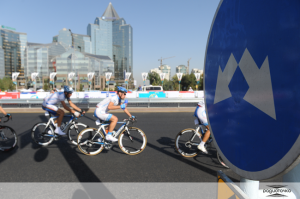 ALMATY – Bicycle lanes are to be built in Almaty, following the suggestions of Dutch experts engaged in a project to improve the city’s traffic infrastructure.
ALMATY – Bicycle lanes are to be built in Almaty, following the suggestions of Dutch experts engaged in a project to improve the city’s traffic infrastructure.
The draft bicycle lanes construction project was presented on May 16 in Almaty during a meeting with Mayor of Almaty City Akhmetzhan Yessimov. The suggestions made by the Dutch experts were welcomed by the mayor who charged responsible administration officers to work on implementing the project .
The first step will be redesigning Timiryazev Street to include different traffic lanes for cars, pubic transport and bicycles. According calculations, cars will get a 2.75-3.25 metre lane while public transport lanes will be 3-3.5 metres. Experts say these measures will reduce the speed of traffic, one of the city’s main safety issues. This would also save space for bicycle lanes and prevent parking along the streets. This suggestion, however, has not been included in the project yet.
The main purpose of the project is to connect the southwest districts of Almaty with the city centre. One proposed bicycle route will pass two universities, which could promote bicycles as student transport. The width of Timiryazev Street between Rozybakiyev and Auezov Streets will allow the construction of a 3-metre wide bicycle lane. This cannot be continued between Auezov Street and the Essentai River Quay, however, because too many trees would have to be cut down.
The project also envisions two one-way bicycle lanes along Shashkin and Baitursynov Streets. It is also planned to rebuild traffic lanes for public transport, improve the canal system and plant trees to separate the main road from the bicycle lanes.
Three bicycle lanes currently exist in the city. The oldest and most-used route runs along Abai Avenue and is 2.5 kilometres long. At the end of 2012, two more lanes appeared along the Talgar Route and Momyshuly Street. Neither is much used by local cyclists. According to Yessimov, there are 90,000 cyclists in Almaty.
According to a survey conducted among Almaty bikers in October 2013, their main problems are the need to share the road with cars and public transport, which they find to be dangerous, uncontrolled pedestrian flows and random parking.


